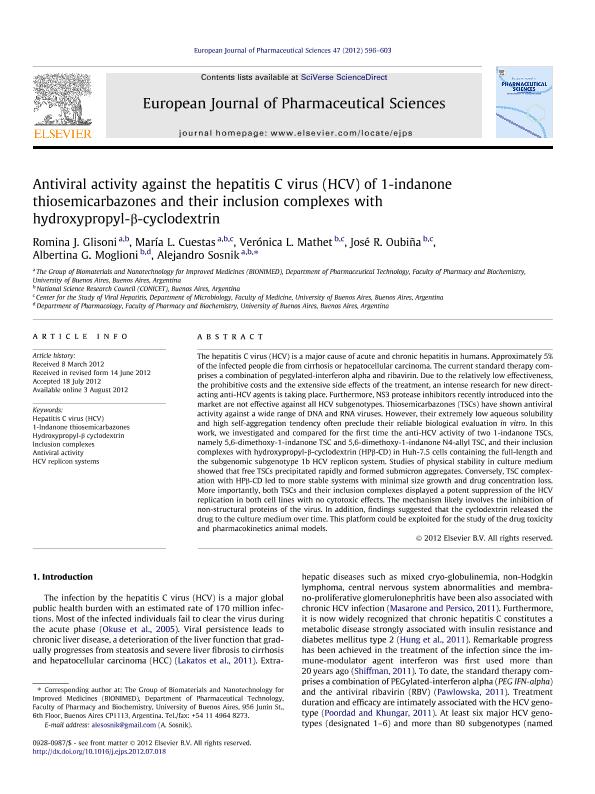Mostrar el registro sencillo del ítem
dc.contributor.author
Glisoni, Romina Julieta

dc.contributor.author
Cuestas, María Luján

dc.contributor.author
Mathet, Veronica Lidia

dc.contributor.author
Oubiña, Jose Raul

dc.contributor.author
Moglioni, Albertina Gladys

dc.contributor.author
Sosnik, Alejandro Dario

dc.date.available
2023-05-18T12:10:54Z
dc.date.issued
2012-10
dc.identifier.citation
Glisoni, Romina Julieta; Cuestas, María Luján; Mathet, Veronica Lidia; Oubiña, Jose Raul; Moglioni, Albertina Gladys; et al.; Antiviral activity against the hepatitis C virus (HCV) of 1-indanone thiosemicarbazones and their inclusion complexes with hydroxypropyl-β- cyclodextrin; Elsevier Science; European Journal of Pharmaceutical Sciences; 47; 3; 10-2012; 596-603
dc.identifier.issn
0928-0987
dc.identifier.uri
http://hdl.handle.net/11336/197940
dc.description.abstract
The hepatitis C virus (HCV) is a major cause of acute and chronic hepatitis in humans. Approximately 5% of the infected people die from cirrhosis or hepatocellular carcinoma. The current standard therapy comprises a combination of pegylated-interferon alpha and ribavirin. Due to the relatively low effectiveness, the prohibitive costs and the extensive side effects of the treatment, an intense research for new direct-acting anti-HCV agents is taking place. Furthermore, NS3 protease inhibitors recently introduced into the market are not effective against all HCV subgenotypes. Thiosemicarbazones (TSCs) have shown antiviral activity against a wide range of DNA and RNA viruses. However, their extremely low aqueous solubility and high self-aggregation tendency often preclude their reliable biological evaluation in vitro. In this work, we investigated and compared for the first time the anti-HCV activity of two 1-indanone TSCs, namely 5,6-dimethoxy-1-indanone TSC and 5,6-dimethoxy-1- indanone N4-allyl TSC, and their inclusion complexes with hydroxypropyl-β- cyclodextrin (HPβ-CD) in Huh-7.5 cells containing the full-length and the subgenomic subgenotype 1b HCV replicon system. Studies of physical stability in culture medium showed that free TSCs precipitated rapidly and formed submicron aggregates. Conversely, TSC complexation with HPβ-CD led to more stable systems with minimal size growth and drug concentration loss. More importantly, both TSCs and their inclusion complexes displayed a potent suppression of the HCV replication in both cell lines with no cytotoxic effects. The mechanism likely involves the inhibition of non-structural proteins of the virus. In addition, findings suggested that the cyclodextrin released the drug to the culture medium over time. This platform could be exploited for the study of the drug toxicity and pharmacokinetics animal models.
dc.format
application/pdf
dc.language.iso
eng
dc.publisher
Elsevier Science

dc.rights
info:eu-repo/semantics/openAccess
dc.rights.uri
https://creativecommons.org/licenses/by-nc-sa/2.5/ar/
dc.subject
1-INDANONE THIOSEMICARBAZONES
dc.subject
ANTIVIRAL ACTIVITY
dc.subject
HCV REPLICON SYSTEMS
dc.subject
HEPATITIS C VIRUS (HCV)
dc.subject
HYDROXYPROPYL-Β CYCLODEXTRIN
dc.subject
INCLUSION COMPLEXES
dc.subject.classification
Otras Nanotecnología

dc.subject.classification
Nanotecnología

dc.subject.classification
INGENIERÍAS Y TECNOLOGÍAS

dc.title
Antiviral activity against the hepatitis C virus (HCV) of 1-indanone thiosemicarbazones and their inclusion complexes with hydroxypropyl-β- cyclodextrin
dc.type
info:eu-repo/semantics/article
dc.type
info:ar-repo/semantics/artículo
dc.type
info:eu-repo/semantics/publishedVersion
dc.date.updated
2023-05-15T14:04:46Z
dc.journal.volume
47
dc.journal.number
3
dc.journal.pagination
596-603
dc.journal.pais
Países Bajos

dc.journal.ciudad
Amsterdam
dc.description.fil
Fil: Glisoni, Romina Julieta. Universidad de Buenos Aires. Facultad de Farmacia y Bioquímica. Departamento de Tecnología Farmacéutica; Argentina. Consejo Nacional de Investigaciones Científicas y Técnicas; Argentina
dc.description.fil
Fil: Cuestas, María Luján. Universidad de Buenos Aires. Facultad de Farmacia y Bioquímica. Departamento de Tecnología Farmacéutica; Argentina. Consejo Nacional de Investigaciones Científicas y Técnicas; Argentina
dc.description.fil
Fil: Mathet, Veronica Lidia. Universidad de Buenos Aires. Facultad de Medicina. Departamento de Microbiología. Área Virología; Argentina. Consejo Nacional de Investigaciones Científicas y Técnicas; Argentina
dc.description.fil
Fil: Oubiña, Jose Raul. Universidad de Buenos Aires. Facultad de Medicina. Departamento de Microbiología. Área Virología; Argentina. Consejo Nacional de Investigaciones Científicas y Técnicas; Argentina
dc.description.fil
Fil: Moglioni, Albertina Gladys. Universidad de Buenos Aires; Argentina. Consejo Nacional de Investigaciones Científicas y Técnicas; Argentina
dc.description.fil
Fil: Sosnik, Alejandro Dario. Universidad de Buenos Aires. Facultad de Farmacia y Bioquímica. Departamento de Tecnología Farmacéutica; Argentina. Consejo Nacional de Investigaciones Científicas y Técnicas; Argentina
dc.journal.title
European Journal of Pharmaceutical Sciences

dc.relation.alternativeid
info:eu-repo/semantics/altIdentifier/url/https://www.sciencedirect.com/science/article/pii/S0928098712002965
dc.relation.alternativeid
info:eu-repo/semantics/altIdentifier/doi/http://dx.doi.org/10.1016/j.ejps.2012.07.018
Archivos asociados
